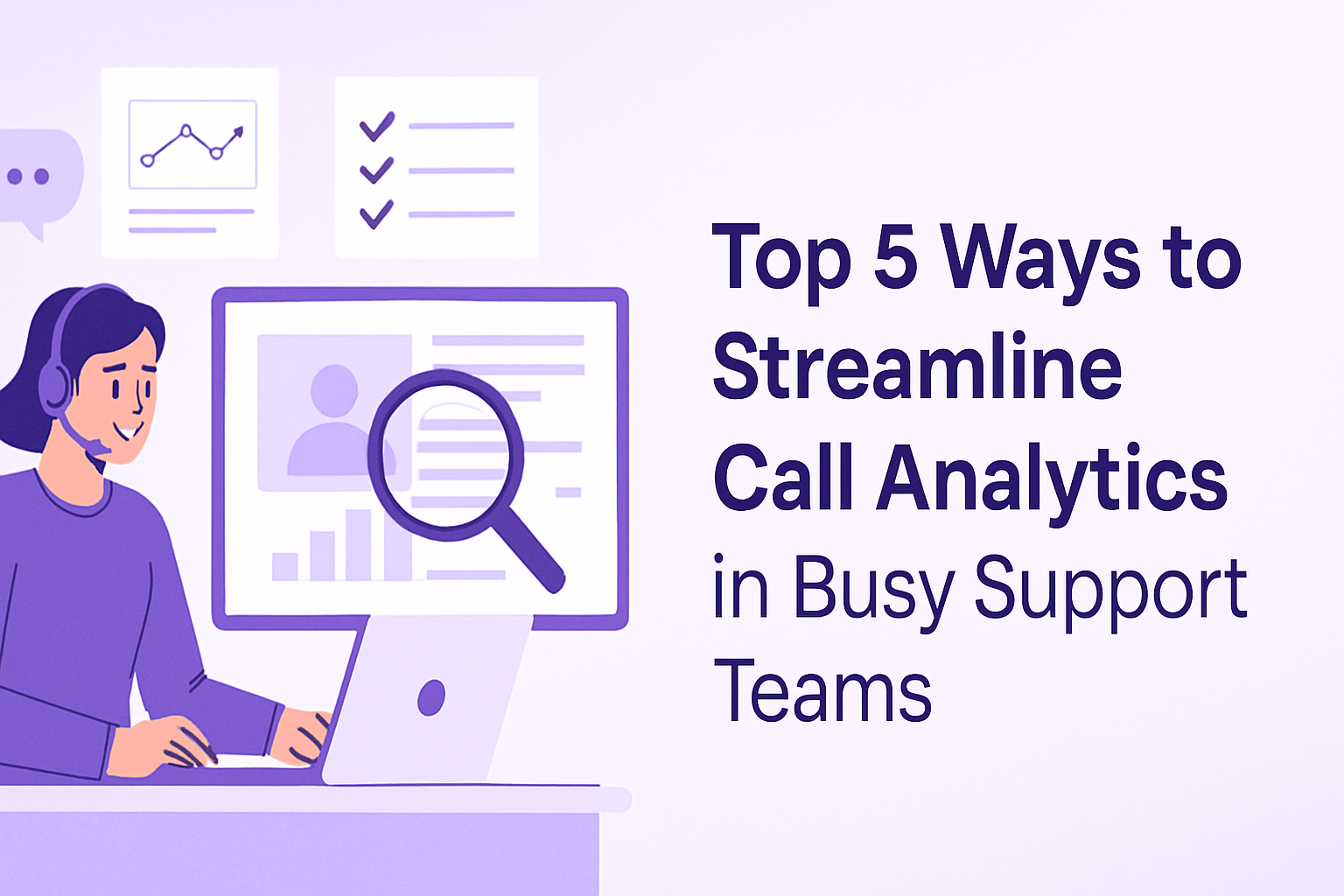Best Practices for Measuring the Impact of Sales Training with Call Analytics
-
Hello Insight
- 10 min read
Best Practices for Measuring the Impact of Sales Training with Call Analytics
Measuring the effectiveness of sales training can often feel like a daunting task. With so many variables at play, how can organizations truly understand if their training efforts are yielding the desired results? Enter call analytics. By leveraging call analytics, businesses can gain valuable insights into the impact of their sales training programs, ultimately leading to improved performance and customer satisfaction. This guide explores best practices for utilizing call analytics to measure the impact of sales training effectively.
The Role of Call Analytics in Modern Sales Training
In today's fast-paced business environment, effective sales training is crucial for driving revenue and ensuring customer satisfaction. Call analytics has become an essential tool for organizations looking to enhance their sales training initiatives. By analyzing the conversations between sales representatives and customers, companies can identify strengths, weaknesses, and areas for improvement.
Traditional sales training methods often rely on subjective assessments, which can lead to inconsistent results and missed opportunities for growth. Call analytics shifts this paradigm from reactive to proactive, providing organizations with data-driven insights that can inform training programs. This approach not only optimizes the training process but also aligns sales teams around common goals and objectives.
To implement call analytics effectively, organizations need to adopt specific technologies and processes that streamline data collection and analysis. This may include integrating tools like InsightGraph, which aggregates insights from multiple customer communication channels, allowing for a comprehensive view of sales interactions.
What is Call Analytics?
Call analytics refers to the process of collecting, analyzing, and interpreting data from customer calls to improve business performance. This method involves various analytical techniques, including speech recognition, sentiment analysis, and conversation mapping, to derive actionable insights.
Unlike traditional approaches that focus on historical performance metrics, call analytics emphasizes real-time data analysis. By examining live conversations, organizations can quickly identify trends, uncover customer pain points, and assess the effectiveness of their sales training initiatives.
Core Capabilities:
- Performance Tracking: Enables organizations to monitor sales representatives' performance in real-time, leading to timely interventions.
- Sentiment Analysis: Provides insights into customer emotions during calls, helping to identify areas for improvement in sales techniques.
- Trend Identification: Helps pinpoint common customer inquiries and issues, allowing companies to adjust their training accordingly.
- Quality Assurance: Ensures that sales representatives adhere to best practices and company policies during customer interactions.
- Feedback Loops: Facilitates ongoing feedback between sales teams and management to refine training programs continually.
Strategic Value: Call analytics empowers organizations to make data-driven decisions, ensuring that sales training is aligned with customer needs and market demands.
Why Are Consultants and Insight-Seeking Personnel Investing in Call Analytics?
Organizations are increasingly moving away from outdated training methods due to several compelling reasons:
Key Drivers:
- Data-Driven Decision Making: Traditional training often relies on anecdotal evidence. Call analytics allows organizations to base their strategies on concrete data.
- Enhanced Customer Experience: Understanding customer sentiment and pain points can directly improve service quality, leading to higher customer satisfaction and retention.
- Operational Efficiency: Automating the analysis of calls saves time for managers and allows them to focus on strategic initiatives.
- Performance Improvement: Continuous insights into sales interactions enable organizations to identify skill gaps and adjust training programs in real-time.
What Data Powers Call Analytics?
To harness the full potential of call analytics, organizations must access a variety of data sources that contribute to a comprehensive understanding of customer interactions.
Data Sources:
- Call Recordings: Audio recordings of sales calls provide the raw material for analysis.
- CRM Systems: Integrating data from platforms like Salesforce and HubSpot enhances the context around customer interactions.
- Customer Feedback: Surveys and feedback forms help validate insights derived from call analytics.
- Social Media Insights: Monitoring social media interactions can provide additional context to customer sentiment.
- Training Materials: Analyzing the content of training sessions can help align training efforts with customer needs.
Accuracy Benefit: A diverse data approach increases the reliability of insights, enabling organizations to make informed decisions that drive performance.
Key Components of a Call Analytics Stack
A robust call analytics stack consists of several critical components that work together to deliver insights.
Component Descriptions:
- Call Recording: Captures conversations for later analysis.
- Speech Analytics: Transforms audio data into text for deeper analysis.
- Sentiment Analysis Tools: Evaluates customer emotions based on language used during calls.
- Reporting Dashboards: Visualizes analytics data for easy interpretation and decision-making.
- Integration Capabilities: Ensures seamless data flow between various software tools, enhancing analysis.
Quality Emphasis: The effectiveness of call analytics hinges not just on the quantity of data collected, but also on its quality and interpretability.
Success Dependency: Organizations must ensure high-quality input signals to derive meaningful insights from their call analytics initiatives.
How Does Call Analytics Work Step by Step?
Step 1: Data Collection
Collect audio recordings from sales calls across various platforms, including Zoom and CRM systems.
Step 2: Data Processing
Utilize speech recognition technology to transcribe audio data into text, making it easier to analyze.
Step 3: Data Analysis
Identify key patterns such as customer objections, frequently asked questions, and successful sales strategies.
- Pattern Type 1: Objection handling techniques
- Pattern Type 2: Effective openers and closers
- Pattern Type 3: Customer sentiment shifts
Step 4: Training Insights
Utilize historical data to inform ongoing training efforts, focusing on areas where sales representatives struggle.
Step 5: Real-time Monitoring
Implement real-time call monitoring to provide immediate feedback and coaching opportunities.
Step 6: Reporting and Recommendations
Generate reports that highlight key insights and actionable recommendations for improving sales training.
- Example Output 1: Top-performing sales techniques
- Example Output 2: Common customer objections and effective responses
- Example Output 3: Recommendations for targeted training sessions
Where Can Consultants Apply Call Analytics?
Sales Performance Improvement
- Prediction Method: Analyze call data to forecast individual sales performance.
- Recommended Action: Provide targeted coaching based on identified weaknesses.
Customer Experience Optimization
- Analysis Approach: Utilize sentiment analysis to gauge customer satisfaction.
- Follow-Up Action: Adjust sales scripts based on customer feedback trends.
Training Program Development
- Identification Method: Pinpoint common training gaps through data analysis.
- Proactive Scheduling: Schedule training sessions focused on identified skill deficits.
Forecasting Sales Trends
- Forecasting Approach: Use historical call data to predict future sales trends.
- Optimization Action: Adjust marketing strategies based on predicted customer behavior.
What Tools Can You Use for Call Analytics?
When selecting a call analytics platform, organizations should look for options that offer comprehensive features tailored to their needs.
Comparison Table:
| Feature | InsightGraph | Traditional Call Analysis Tools |
|---|---|---|
| Call Recording | Yes | Yes |
| Sentiment Analysis | Yes | Limited |
| Integration Capabilities | Extensive | Basic |
| Real-time Analytics | Yes | No |
| Reporting Dashboards | Customizable | Static |
Common Pitfalls in Call Analytics Implementation
Organizations often encounter challenges when implementing call analytics, leading to suboptimal outcomes.
Major Pitfalls:
- Data Overload: Gathering too much data without a clear analysis strategy can lead to confusion.
- Stakeholder Misalignment: Lack of buy-in from key stakeholders can hinder effective integration.
- Technical Limitations: Insufficient technical infrastructure may impair the analysis process.
- Poor Integration: Incompatibility with existing systems can limit the effectiveness of call analytics.
Success Foundation: Avoiding these pitfalls begins with a well-defined strategy that prioritizes alignment and clarity.
How Do You Get Started with InsightGraph?
Step 1: Integration
Ensure InsightGraph integrates seamlessly with existing tools like CRM and call platforms.
Step 2: Data Synchronization
Synchronize historical and live data from various sources to create a comprehensive dataset.
Step 3: Configuration
Configure the platform to align with organizational goals and key performance indicators.
Step 4: Training
Provide training to staff on how to leverage call analytics for ongoing improvements.
Step 5: Customization
Customize dashboards and reports to meet the needs of different stakeholders.
Step 6: Continuous Optimization
Regularly review and refine the analytics process to enhance effectiveness.
What Is The Best Call Analytics Setup?
ROI Optimization: To ensure maximum return on investment, businesses should implement best practices tailored to their specific needs.
Best Practices:
- Diverse Data Sources: Utilize multiple data sources to enhance insight accuracy.
- Stakeholder Involvement: Involve all relevant teams in the analytics process for better alignment.
- Historical Data Utilization: Analyze historical data to inform future training programs.
- Regular Reviews: Conduct periodic reviews of analytics processes to identify areas for improvement.
- Automation Integration: Leverage automation to streamline data collection and analysis.
Building a Call Analytics Strategy That Scales
A scalable call analytics strategy requires cross-functional collaboration and alignment. Different teams must define shared goals and metrics for success. By prioritizing diverse data sources, organizations can enhance their analytics capabilities, ensuring ongoing refinement and adaptation to changing market conditions.
Call Analytics Benchmarks and Success Metrics
To measure the impact of call analytics effectively, organizations must establish clear benchmarks and success metrics.
Core Metrics:
- Call Conversion Rate (measures the percentage of calls leading to sales)
- Customer Satisfaction Score (assesses customer sentiment)
- First Call Resolution Rate (tracks the percentage of issues resolved on the first call)
- Average Handle Time (measures the time spent on calls)
- Training Effectiveness Score (evaluates the impact of training on sales performance)
Universal Principle: The ultimate goal of call analytics is to facilitate better decision-making and drive positive action across the organization.
Frequently Asked Questions
Q: What is call analytics?
A: Call analytics is the process of collecting and analyzing data from customer calls to improve performance and customer experience.
Q: How does call analytics differ from traditional methods?
A: Call analytics focuses on real-time data and insights, while traditional methods rely on historical performance metrics.
Q: What platforms are compatible with call analytics?
A: Many platforms, including CRM systems like Salesforce and chat tools like Slack, can integrate with call analytics software.
Q: What data sources enhance call analytics effectiveness?
A: Ideal data sources include call recordings, CRM data, customer feedback, and social media insights.
Q: How long does implementation take?
A: Implementation speed varies but often takes a few weeks to ensure proper integration and training.
Q: What security measures are in place for call analytics?
A: Call analytics tools prioritize data security and compliance with regulations like GDPR and HIPAA.






